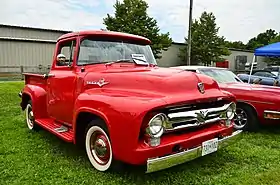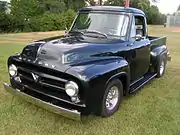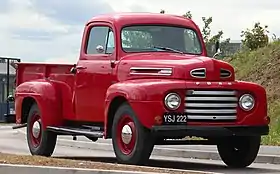Ford F-Series (second generation)
The second generation of the Ford F-Series is a series of trucks that was produced by Ford from the 1953 to 1956 model years. In line with the previous generation, the F-Series encompassed a wide range of vehicles, ranging from light-duty pickup trucks to heavy-duty commercial vehicles.[4] In place of the previous "Bonus-Built" series, Ford now marketed its truck range as the "Triple Economy" series.[5]
| Second generation | |
|---|---|
 | |
| Overview | |
| Manufacturer | Ford |
| Also called | Mercury M-Series |
| Production | 1952–1956[1] 1957–1962 (Brazil) |
| Assembly | Chester, Pennsylvania, USA Dearborn, Michigan, USA Edison, New Jersey, USA Long Beach, California, USA Norfolk, Virginia, USA St. Paul, Minnesota, USA St. Louis, Missouri, USA São Paulo, Brazil (Ford Brazil) Hapeville, Georgia, USA Louisville, Kentucky, USA San Jose, California, USA Highland Park, Michigan, USA |
| Body and chassis | |
| Class | Full-size pickup truck |
| Body style | 2-door pickup 4-door panel truck |
| Layout | Front engine, rear-wheel drive / four-wheel drive |
| Powertrain | |
| Engine | 215 CID (3.5 L) I6 223 CID (3.7 L) Mileage Maker I6 239 CID (3.9 L) Flathead V8 239 CID (3.9 L) Y-block V8 256 CID (4.2 L) Y-block V8 279 CID (4.6 L) Lincoln Y-block V8 317 CID (5.2 L) Lincoln Y-block V8 390 CID (5.9 L) Lincoln Y-block V8 |
| Transmission | Heavy-duty 3-speed manual[2] 3-speed automatic[3] 4-speed manual Ford-O-Matic[3] |
| Dimensions | |
| Wheelbase | 110.0 in (2,794 mm) (F-100) 118.0 in (2,997 mm) (F-250)[3] 130 in (3,302 mm) (F-350) |
| Length | 189.1 in (4,803 mm) (F-100)[3] |
| Chronology | |
| Predecessor | Ford F-Series first generation (1948–1952) |
| Successor | Ford F-Series third generation (1957–1960) |
To further emphasize the model update, Ford changed the F-Series model nomenclature from a single number to three numbers; subsequently, this system has remained in use on all Ford F-Series trucks to the present day.
Alongside the naming change, this generation marked several firsts for the F-Series, including an adjustable seat (wide enough for 3 people),[6] power brakes,[7][8] and the introduction of the Ford-O-Matic automatic transmission as an option. In line with Ford cars, seat belts were introduced as an option for 1956.[3]
The second-generation F-Series was produced by Ford at eleven facilities across the United States; Ford Canada marketed the model line under both the F-Series and the Mercury M-Series nameplates. Ford of Brazil inaugurated local production with the model line, producing it from 1957 to 1962.
Model overview
1956 update
The 1956 F-100 is a one-year only body style. The 1956 F-100 is easily identified as it has vertical windshield pillars and a wrap around windshield as opposed to the sloped pillars and angled windshield of the 1953-55. The 1956 model also offered a larger wraparound back window as an option.
Powertrain details
The 1954 F-100 was the last year for the flathead engine in the US. Models in Canada, however, (Mercury M-Series), retained the flathead. 1954-55 saw the introduction of the new 239 CID overhead valve Y-block V8, dubbed "Power King." The six-cylinder engine's displacement was also increased from 215 to 223 CID and power steering was introduced as an option. In the succeeding years the 239 Y-block was replaced with the 256, 272 and 312.
| Engine | Years | Power |
|---|---|---|
| 215 cu in (3,520 cm3) Straight-6 | 1953 | 101 hp (75 kW) |
| 239 cu in (3,920 cm3) Flathead V8 | 1953 | 100 hp (75 kW) |
| 223 cu in (3,650 cm3) Mileage Maker I6 | 1954–55 | 115 hp (86 kW) |
| 239 cu in (3,920 cm3) Y-block V8 | 1954–55 | 130 hp (97 kW) |
| 223 cu in (3,650 cm3) Mileage Maker I6 | 1956 | 137 hp (102 kW) |
| 256 cu in (4,200 cm3) Y-block V8 | 1955 | 140 hp (104 kW) |
| 272 cu in (4,460 cm3) Truck 2V Y-block V8 | 1956 | 172 hp (128 kW) |
| 279 cu in (4,570 cm3) Lincoln Y-block V8 | 1954-56 | 152 hp (113 kW) |
| 317 cu in (5,190 cm3) Lincoln Y-block V8 | 1954-56 | 170 hp (127 kW) |
| 368 cu in (6,030 cm3) Lincoln Y-block V8 | 1956 | 300 hp (224 kW) |
Models
As part of the model change from the first generation, the model nomenclature for the F-Series was changed from the F-Series was changed from a single number denoting each model series to a three-digit model number; this system remains in use today.
The 1⁄2-ton F-1 became the F-100, the F-2 and F-3 were consolidated into the 3⁄4-ton F-250, with the F-4 becoming the F-350. The medium-duty F-5 (1 1⁄2-ton) and F-6 (2-ton) became the F-500 and F-600, respectively. The heavy-duty F-7, F-8, and F-9 "Big Job" trucks became the F-700, F-750, F-800, and F-900 series.
For 1956, lower GVWR versions of the F-100 and the F-250 were introduced (under the F-110 and F-260 model codes).[3]
Gallery
 1953 Mercury M-100, a Canada-only rebadged F-100
1953 Mercury M-100, a Canada-only rebadged F-100 1953 Ford F-100
1953 Ford F-100.JPG.webp) 1955 Ford F-100
1955 Ford F-100.jpg.webp) 1956 Mercury M-100 pickup
1956 Mercury M-100 pickup.JPG.webp) 1956 Ford F-100
1956 Ford F-100
References
- Bunn, Don. Classic Ford F-Series Pickup Trucks, 1948-1956. ISBN 9781610608800.
- "Directory Index: FMC Trucks-Vans/1955_Trucks_and_Vans/1955_Ford_F-100_Truck_Brochure". Oldcarbrochures.com. Retrieved 2012-03-03.
- Gunnell, John A. (1993). Standard Catalog of American Light-Duty Trucks. krause Publications. ISBN 0-87341-238-9.
- "1954 Ford Trucks Full Line Brochure". www.oldcarbrochures.com. Retrieved 2020-07-17.
- "1954 Ford Trucks Full Line Brochure". www.oldcarbrochures.com. Retrieved 2020-07-17.
- "1954 Ford Trucks Full Line Brochure". www.oldcarbrochures.com. Retrieved 2020-07-17.
- "1954 Ford F100 Truck Brochure". www.oldcarbrochures.com. Retrieved 2020-07-17.
- "1954 Ford Trucks Full Line Brochure". www.oldcarbrochures.com. Retrieved 2020-07-17.

_front_view_01.png.webp)